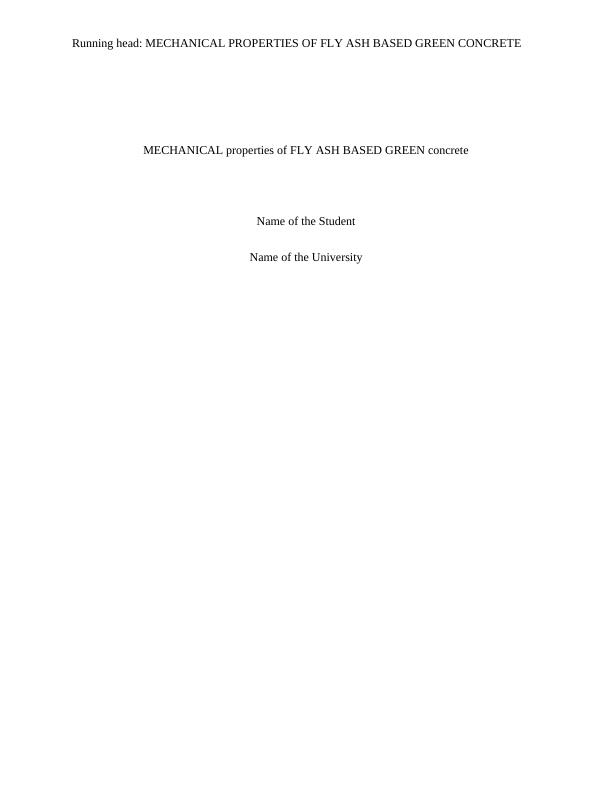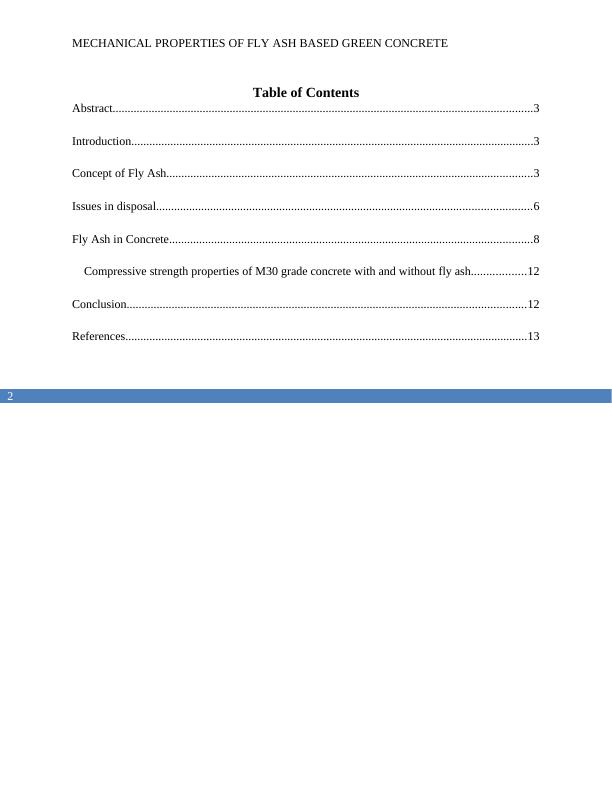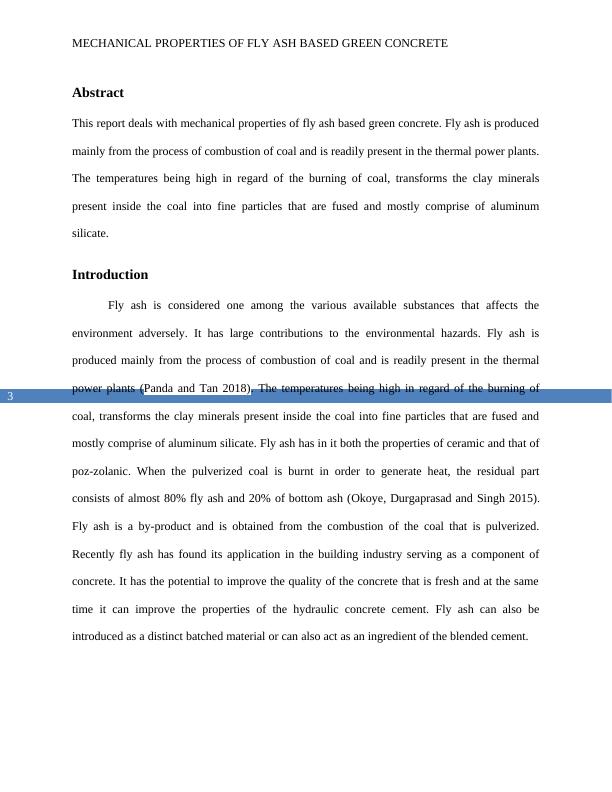Mechanical Properties of Fly Ash Based Green Concrete Report 2022
Added on 2022-10-19
15 Pages3558 Words12 Views
Running head: MECHANICAL PROPERTIES OF FLY ASH BASED GREEN CONCRETE
MECHANICAL properties of FLY ASH BASED GREEN concrete
Name of the Student
Name of the University
MECHANICAL properties of FLY ASH BASED GREEN concrete
Name of the Student
Name of the University

2
MECHANICAL PROPERTIES OF FLY ASH BASED GREEN CONCRETE
Table of Contents
Abstract............................................................................................................................................3
Introduction......................................................................................................................................3
Concept of Fly Ash..........................................................................................................................3
Issues in disposal.............................................................................................................................6
Fly Ash in Concrete.........................................................................................................................8
Compressive strength properties of M30 grade concrete with and without fly ash..................12
Conclusion.....................................................................................................................................12
References......................................................................................................................................13
MECHANICAL PROPERTIES OF FLY ASH BASED GREEN CONCRETE
Table of Contents
Abstract............................................................................................................................................3
Introduction......................................................................................................................................3
Concept of Fly Ash..........................................................................................................................3
Issues in disposal.............................................................................................................................6
Fly Ash in Concrete.........................................................................................................................8
Compressive strength properties of M30 grade concrete with and without fly ash..................12
Conclusion.....................................................................................................................................12
References......................................................................................................................................13

3
MECHANICAL PROPERTIES OF FLY ASH BASED GREEN CONCRETE
Abstract
This report deals with mechanical properties of fly ash based green concrete. Fly ash is produced
mainly from the process of combustion of coal and is readily present in the thermal power plants.
The temperatures being high in regard of the burning of coal, transforms the clay minerals
present inside the coal into fine particles that are fused and mostly comprise of aluminum
silicate.
Introduction
Fly ash is considered one among the various available substances that affects the
environment adversely. It has large contributions to the environmental hazards. Fly ash is
produced mainly from the process of combustion of coal and is readily present in the thermal
power plants (Panda and Tan 2018). The temperatures being high in regard of the burning of
coal, transforms the clay minerals present inside the coal into fine particles that are fused and
mostly comprise of aluminum silicate. Fly ash has in it both the properties of ceramic and that of
poz-zolanic. When the pulverized coal is burnt in order to generate heat, the residual part
consists of almost 80% fly ash and 20% of bottom ash (Okoye, Durgaprasad and Singh 2015).
Fly ash is a by-product and is obtained from the combustion of the coal that is pulverized.
Recently fly ash has found its application in the building industry serving as a component of
concrete. It has the potential to improve the quality of the concrete that is fresh and at the same
time it can improve the properties of the hydraulic concrete cement. Fly ash can also be
introduced as a distinct batched material or can also act as an ingredient of the blended cement.
MECHANICAL PROPERTIES OF FLY ASH BASED GREEN CONCRETE
Abstract
This report deals with mechanical properties of fly ash based green concrete. Fly ash is produced
mainly from the process of combustion of coal and is readily present in the thermal power plants.
The temperatures being high in regard of the burning of coal, transforms the clay minerals
present inside the coal into fine particles that are fused and mostly comprise of aluminum
silicate.
Introduction
Fly ash is considered one among the various available substances that affects the
environment adversely. It has large contributions to the environmental hazards. Fly ash is
produced mainly from the process of combustion of coal and is readily present in the thermal
power plants (Panda and Tan 2018). The temperatures being high in regard of the burning of
coal, transforms the clay minerals present inside the coal into fine particles that are fused and
mostly comprise of aluminum silicate. Fly ash has in it both the properties of ceramic and that of
poz-zolanic. When the pulverized coal is burnt in order to generate heat, the residual part
consists of almost 80% fly ash and 20% of bottom ash (Okoye, Durgaprasad and Singh 2015).
Fly ash is a by-product and is obtained from the combustion of the coal that is pulverized.
Recently fly ash has found its application in the building industry serving as a component of
concrete. It has the potential to improve the quality of the concrete that is fresh and at the same
time it can improve the properties of the hydraulic concrete cement. Fly ash can also be
introduced as a distinct batched material or can also act as an ingredient of the blended cement.

4
MECHANICAL PROPERTIES OF FLY ASH BASED GREEN CONCRETE
Concept of Fly Ash
As per the research done by Ranjbar et al. (2016), In the recent days huge amount of fly
ash has been made use of in the concrete used for the structural building. Super plasticizers are
being made used of in order to overcome the various deficiencies resulting from replacement of
the cement with the huge volumes of the material in the hydraulic cement concrete. Fly ash
concrete has been a newly accepted building material that is helping build durable and
sustainable infrastructures. Compared to cement fly ash is available readily. The production of
cement releases huge amount of the poisonous gas that is carbon dioxide and is not at all
environment friendly. The production of 1ton cement produces near about 1ton of carbon dioxide
and the process of production of cement is also costly thus fly ash can be adopted in the building
industries as a building material along with concrete. As per the research done by Embong et al.
(2016), in the year 1998 the production of fly ash was approximately 390 million tons but only
14% of the production was used as then it was not known that it could be an effective building
material owing to its material property. At present the production of fly ash is around 800 million
tons. The CO2 related energy taxes are mainly focusing on the consumption of fuel and not on the
actual rate of emission of the gas (Karthik, Sudalaimani and Kumar 2017). The ordinary Portland
cement is used in the industry of aggregates is the outcome of the process of calcinations of
calcium carbonate and silica based on the following reaction:
5CaCO3 + 2SiO2—> (3CaO, SiO2) (2CaO, SiO2) + 5CO2
The production of 1 ton cement is involved in the direct generation of 0.55 tons of the
chemical-CO2 and it requires the combustion of the carbon-fuel in order to yield additional 0.40
tons of CO2. In simple terms it can be said that 1ton of cement = 1ton of CO2. In the year 1987
almost 1 billion metric ton of the production of cement throughout the world was responsible for
MECHANICAL PROPERTIES OF FLY ASH BASED GREEN CONCRETE
Concept of Fly Ash
As per the research done by Ranjbar et al. (2016), In the recent days huge amount of fly
ash has been made use of in the concrete used for the structural building. Super plasticizers are
being made used of in order to overcome the various deficiencies resulting from replacement of
the cement with the huge volumes of the material in the hydraulic cement concrete. Fly ash
concrete has been a newly accepted building material that is helping build durable and
sustainable infrastructures. Compared to cement fly ash is available readily. The production of
cement releases huge amount of the poisonous gas that is carbon dioxide and is not at all
environment friendly. The production of 1ton cement produces near about 1ton of carbon dioxide
and the process of production of cement is also costly thus fly ash can be adopted in the building
industries as a building material along with concrete. As per the research done by Embong et al.
(2016), in the year 1998 the production of fly ash was approximately 390 million tons but only
14% of the production was used as then it was not known that it could be an effective building
material owing to its material property. At present the production of fly ash is around 800 million
tons. The CO2 related energy taxes are mainly focusing on the consumption of fuel and not on the
actual rate of emission of the gas (Karthik, Sudalaimani and Kumar 2017). The ordinary Portland
cement is used in the industry of aggregates is the outcome of the process of calcinations of
calcium carbonate and silica based on the following reaction:
5CaCO3 + 2SiO2—> (3CaO, SiO2) (2CaO, SiO2) + 5CO2
The production of 1 ton cement is involved in the direct generation of 0.55 tons of the
chemical-CO2 and it requires the combustion of the carbon-fuel in order to yield additional 0.40
tons of CO2. In simple terms it can be said that 1ton of cement = 1ton of CO2. In the year 1987
almost 1 billion metric ton of the production of cement throughout the world was responsible for

End of preview
Want to access all the pages? Upload your documents or become a member.
Related Documents
42908 Engineering Project Preparationlg...
|14
|3403
|377
Fly Ash Cement pva fibers Assignment PDFlg...
|9
|3059
|23
Selection of Building Materials: Raw Materials, Manufacturing Process, Onsite Installation, Testing Techniques, Advantages and Disadvantageslg...
|13
|2197
|249
Zero/low-carbon design technology to scale the emissions of fossil fuel combustionlg...
|10
|1796
|56
Materials and Manufacturing Processeslg...
|10
|3411
|27
